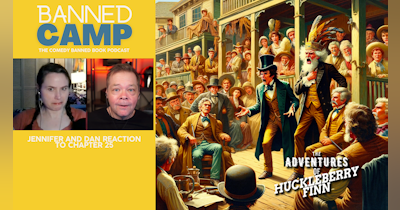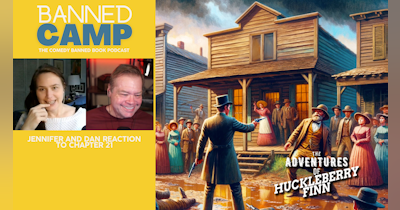If you're one of those curious souls who can't resist a good literary debate, a hearty laugh, and a dash of irreverence, then you're in for a treat. In a recent episode of "Banned Camp," the podcast where the banned books are celebrated rather than shunned, Jennifer and Dan took a deep dive into Chapters 14 and 15 of Mark Twain's timeless classic, "The Adventures of Huckleberry Finn" (Listen to the episode here).
Banned Camp isn't your typical book club podcast. No, it's a witty and thought-provoking exploration of banned literature. This show, with its unique format, offers something truly exceptional. In these chapters, they not only dissect the plot but also dive headfirst into the themes, characters, and the potential reasons behind the book's banning.
So, whether you're a lover of classic literature, intrigued by the mystery of banned books, or just looking for a refreshing take on the written word, join us as we unravel the layers of Chapters 14 and 15 of "The Adventures of Huckleberry Finn." Let's embark on a journey that's as insightful as it is uproarious, all while shedding light on the broader themes of censorship and literary freedom.
What Are Chapters 14 and 15 of "The Adventures of Huckleberry Finn" About?
Before we delve deeper into the themes and controversies surrounding these chapters, let's set the stage and provide a snapshot of what unfolds in Chapters 14 and 15 of Mark Twain's literary gem. If you're eager to catch up on all the Banned Camp episodes dedicated to "The Adventures of Huckleberry Finn," you can find them here in the archives.
In Chapter 14, we find our intrepid duo, Huck and Jim, aboard the stolen Walter Scott. With a haul of spoils from the gang they've encountered, including blankets, clothes, cigars, and even a few books, the scene is set for adventure and intrigue. But as Huck revels in the newfound treasure, Jim's apprehensions loom large. His fear that they may have been caught or could end up drowned tempers Huck's excitement. As the two characters navigate this delicate balance, the chapter also delves into Huck's readings about romantic figures like kings, dukes, and earls. And of course, it wouldn't be "The Adventures of Huckleberry Finn" without some witty banter, as Huck and Jim engage in a spirited debate about the wisdom of King Solomon.
Chapter 15 sees Huck and Jim inching closer to their goal, Cairo, Illinois, where they plan to catch a steamboat to the free states. The anticipation of freedom runs high. However, a dense fog rolls in on the second night, and the strong current of the Mississippi River separates Huck and Jim. The episode unfolds with a mix of suspense and humor as Huck, ever the trickster, decides to play a prank on Jim, pretending as though he never left the raft. The ensuing emotional rollercoaster between the two characters adds depth and complexity to their relationship.
While the chapters brim with adventure and the charm of Twain's storytelling, they also hold subtle layers of meaning and invite us to contemplate the complexities of friendship, freedom, and the human spirit. In the next sections, we'll explore these themes and the potential reasons why these chapters have found themselves on the banned books list. And who knows, we might just uncover a comedic gem from the episode to tickle your funny bone along the way.
Character Development
In the tumultuous journey through "The Adventures of Huckleberry Finn," Chapters 14 and 15 bring forth a fascinating evolution in the characters of Huck and Jim. The beauty of Twain's storytelling lies not only in the adventurous plot but also in the profound transformation and development of his protagonists.
Huck's Growth and Complexity
Huck Finn, our young and mischievous narrator, continues to mature and confront the complexities of his world. In these chapters, we see Huck grappling with newfound responsibilities and ethical dilemmas. His excitement about the stolen treasures is juxtaposed with a growing awareness of the consequences of their actions. As he listens to Jim's concerns and fears, Huck begins to acknowledge the weight of their situation. It's a subtle yet significant moment of growth, highlighting Huck's empathy and the gradual development of his moral compass.
Jim's Protective Instincts
Jim, the runaway slave and Huck's trusted companion, undergoes his own transformation in these chapters. His unwavering dedication to Huck's safety is palpable. Jim's fears about potential dangers and his commitment to looking out for Huck's well-being showcase the depth of his character. The emotional nuances in Jim's reactions, particularly when he believes Huck has vanished in the dense fog, reveal the profound bond between the two characters.
The character development in Chapters 14 and 15 serves as a testament to Mark Twain's storytelling prowess. These chapters not only propel the plot forward but also provide a canvas for exploring the growth, complexity, and humanity of Huck and Jim. As we continue our journey through the banned pages of this classic, keep an eye out for the subtle shifts in their characters, for it is within these moments that the heart of the story truly shines.
Themes and Symbols
Mark Twain's "The Adventures of Huckleberry Finn" is a treasure trove of themes and symbols that paint a vivid picture of the American South during the mid-19th century. In Chapters 14 and 15, these elements come to the forefront, enriching the narrative and sparking discussions that have resonated for generations.
Freedom vs. Conformity
One of the central themes in the novel is the dichotomy between freedom and conformity. Huck's journey down the Mississippi River with Jim symbolizes a quest for freedom, both from societal norms and the constraints of his upbringing. In these chapters, we see the characters inching closer to their goal—Cairo, Illinois, the gateway to the free states. However, the dense fog becomes a symbol of the obstacles and uncertainties that stand in their way, forcing them to confront the fragility of their newfound freedom.
Friendship and Loyalty
The bond between Huck and Jim serves as a powerful symbol of friendship and loyalty. As they navigate the challenges and dangers of their journey, their relationship deepens. In Chapter 15, Huck's prank on Jim, pretending he was never separated, serves as a poignant moment of reflection on the importance of trust and companionship. This theme underscores the novel's exploration of human connection and the recognition of shared humanity, transcending the racial prejudices of the time.
The Mississippi River
The Mississippi River itself is a potent symbol in Twain's work. It represents both freedom and peril, mirroring the characters' inner struggles and external challenges. As they journey down the river, it becomes a metaphorical and literal lifeline, shaping their destinies and testing their resolve.
In these chapters, as we ponder the themes and symbols interwoven into the narrative, we gain a deeper appreciation for Twain's masterful storytelling. The Mississippi River flows not only through the heart of America but also through the heart of the novel, carrying with it a wealth of meaning and significance that continues to captivate readers and inspire discussions on the enduring themes of freedom, friendship, and the human spirit.
Chapter's Impact on the Overall Story
In the grand tapestry of "The Adventures of Huckleberry Finn," Chapters 14 and 15 serve as pivotal threads, contributing significantly to the overall narrative. These chapters not only advance the plot but also deepen our understanding of the characters and the overarching themes of the novel.
Advancement of the Journey
The journey down the Mississippi River is at the core of Huck and Jim's adventure, symbolizing their pursuit of freedom and a better life. Chapter 15 marks a crucial juncture in this journey as they believe they are nearing Cairo, the gateway to the free states. However, the unexpected fog shrouding the river introduces an element of uncertainty and danger, emphasizing the unpredictable nature of their quest. This chapter keeps readers on the edge of their seats, reinforcing the narrative's sense of adventure.
Character Bonds and Conflicts
Huck and Jim's evolving relationship takes center stage in these chapters. As they face challenges and uncertainties together, their bond deepens. Huck's prank in Chapter 15 may seem like a moment of humor, but it also reveals the complexity of their friendship. This chapter illustrates the deep connection between the characters while highlighting the occasional conflicts that arise, making their journey more emotionally resonant.
Foreshadowing and Themes
The fog that separates Huck and Jim in Chapter 15 serves as a literary device with far-reaching implications. It foreshadows the challenges and moral dilemmas that lie ahead in the narrative. It also encapsulates the theme of uncertainty and the blurred lines between right and wrong, adding depth to the story's moral exploration.
In the grand scheme of things, these chapters propel the story forward, test the characters' resolve, and foreshadow the trials they will face. Their impact on the overall narrative of "The Adventures of Huckleberry Finn" is undeniable, setting the stage for the twists and turns that await both Huck and Jim on their journey of self-discovery and freedom.
Banning Triggers: Themes from this Chapter
In the world of literary censorship, certain themes and content often become focal points for those seeking to ban books. Chapters 14 and 15 of "The Adventures of Huckleberry Finn" are no exception. These chapters contain elements that some might consider controversial or objectionable, raising questions about their appropriateness in educational contexts.
Racial Tensions
One of the recurring themes in Twain's novel is the racial tension between Huck, a white boy, and Jim, a black runaway slave. Chapter 15 explores this dynamic as Jim's emotional turmoil over Huck's prank reflects the complexities of their relationship. While the novel portrays the racial prejudices of the time, it does so to critique and challenge them, not to endorse them.
Pranks and Deception
Huck's prank on Jim in Chapter 15, pretending that he was never separated from the raft, raises questions about the ethics of deception. Some may argue that this behavior sets a poor example for young readers. However, it's essential to recognize that this prank is a pivotal moment in the characters' development, highlighting moral dilemmas and the importance of trust.
Moral Ambiguity
Twain masterfully weaves moral ambiguity into the narrative, a hallmark of his writing. The fog in Chapter 15 symbolizes uncertainty and the blurred lines between right and wrong. Some critics may find this moral complexity challenging for young readers. However, it's precisely these shades of gray that invite critical thinking and reflection.
Jennifer and Dan of "Banned Camp" are well aware of these themes and the potential objections they may raise. However, they, like many scholars and educators, recognize that these elements are integral to the novel's depth and societal critique. They can find no reason in the chapters to ban the book based on these themes. Instead, they use their platform to foster discussions about these important issues and the value of confronting them through literature.
As we navigate the waters of Chapters 14 and 15 in "The Adventures of Huckleberry Finn," it becomes abundantly clear that Mark Twain's genius lies not only in his storytelling but also in his ability to provoke thought and spark discussion. These chapters, while filled with adventure and humor, tackle complex themes and challenges that have resonated for generations.
Jennifer and Dan, the dynamic duo behind "Banned Camp," recognize the nuances and potential objections these chapters may raise. Yet, they approach the material with the understanding that literature's power lies in its ability to engage with difficult topics, challenge norms, and encourage critical thinking. They see no reason to ban this classic work based on these chapters, and their podcast is a testament to their commitment to celebrating rather than shunning banned books.
So, whether you're a literature enthusiast, a defender of intellectual freedom, or simply someone who enjoys a good laugh while dissecting the profound, "Banned Camp" welcomes you with open arms. Join us in our quest to uncover the mysteries of the banned book podcast and explore more. The literary adventure awaits!
Further Reading
Banned Books That Shaped America: Discover a curated list of iconic books that have faced censorship and challenges throughout history, shaping American literature and culture.
Read "The Adventures of Huckleberry Finn" by Mark Twain: Immerse yourself in the complete text of Mark Twain's masterpiece, "The Adventures of Huckleberry Finn," and experience the story in its entirety.
Censorship and Literature: A Historical Perspective: Gain insights into the history of book censorship, its impact on literature, and the ongoing debates surrounding intellectual freedom.
American Library Association (ALA) Banned Books Week: Explore the American Library Association's resources dedicated to Banned Books Week, an annual event celebrating the freedom to read and highlighting banned and challenged books.
These resources offer a wealth of information and perspectives on the world of banned books, literature, and the importance of intellectual freedom. Whether you're a seasoned bookworm or a curious newcomer, they provide valuable insights into the ongoing dialogue about the power of literature to challenge, inspire, and transform.











